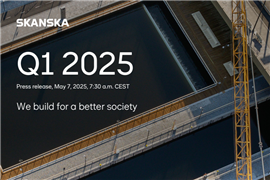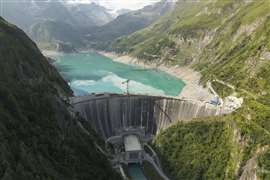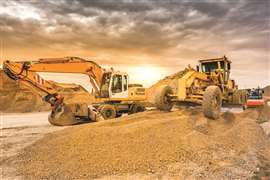Read this article in Français Deutsch Italiano Português Español
Portal North Bridge: Skanska-Traylor JV nears handoff for key US$1.6bn rail megaproject
22 May 2025
A joint venture involving Sweden-based contractor Skanska and US-based Traylor Brothers construction company is nearing completion on its scope of work for the Portal North Bridge project in New Jersey, US, a major regional rail upgrade.
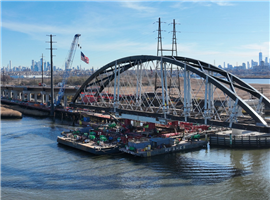 One of the fixed-span elements for the new Portal North Bridge in New Jersey, US, arrives via barge. Image: Skanska
One of the fixed-span elements for the new Portal North Bridge in New Jersey, US, arrives via barge. Image: Skanska
The clients are New Jersey Transit Corporation (NJ Transit) and Amtrak.
The US$1.6-billion bridge-project is a key component of the broader Gateway Program, a multi-phase effort to improve rail infrastructure between New Jersey and New York states (specifically the metropolitan areas in and around New York City). The full Gateway Program, led by the Gateway Development Commission, also includes the construction of new tunnels under the Hudson River and rehabilitation of existing ones, with an estimated total cost of $16 billion.
Once complete, the project is meant to completely reshape and invigorate the country’s busiest rail system (the Northeast Corridor or NEC), which is also one of the most congested and delayed in the country.
The Portal North Bridge phase replaces a 114-year-old swing bridge with a fixed span bridge. The former moveable bridge suffered frequent operational failures – up to 20% of openings resulted in closure issues – which spurred its replacement.
The new fixed-span crossing will rise 50 ft (15m) above the river’s high-water mark, eliminating the need to open for commercial marine traffic. The new bridge should allow trains to cross at speeds exceeding 80 mph (129 km/h) without interruption.
The new bridge will run approximately 2.44 mi (3.9km) in total and includes a 1,200-ft-long (366m) center span over the Hackensack River, with approach spans measuring 3,660 ft (1,116m) on the west side and 2,540 ft (774m) on the east. About 6,180 linear-ft (1,884m) of new embankment supports the rail alignments leading into the new structure, and the twin-track design accommodates increased service frequency and improved reliability across the NEC.
Speaking with Construction Briefing about the scheme was Laszlo Borhi, Skanska project executive, and Michelle Miyaki, Skanska project superintendent. The pair discussed construction logistics, sustainability efforts, and the complexity of building in constrained (and unique mix of) urban and natural environments.
Building through swamps, water, and active rail lines for Portal North Bridge
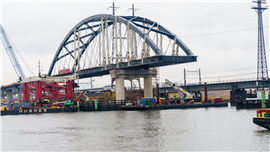 A bridge span arrives is placed for the new Portal North Bridge; a vital rail crossing in the US’ Northeast Corridor. Image: Skanska
A bridge span arrives is placed for the new Portal North Bridge; a vital rail crossing in the US’ Northeast Corridor. Image: Skanska
Access to the jobsite was one of the most significant challenges.
“We had swamps, wetlands, river crossings – a very complex environment,” said Borhi.
The team constructed causeways and trestles to reach work areas without disrupting live rail or sensitive terrain.
And that natural environment was crammed in between sprawling urban development: in addition to the river and wetlands, the site is surrounded by millions of people, including the Newark metropolitan area to the east, and the Jersey City, New Jersey, metro to the west. Together with New York City, these three city metros hold around 20 million people.
To navigate the site challenges, prefabricated bridge elements were staged offsite and transported by barge to minimise height work and river disruption. The move involved crossing under 18 bridges and navigating the ice-prone Hudson River during winter.
“We preassembled all three network-tied arches at the Port of Coeymans and floated the spans down on 80-foot barges,” Miyaki explained, noting they relied on specialty lifting and transport firm Mammoet (Netherlands).
Miyaki added, “We did it all in freezing months and used tide and winches to transfer to our jacking barges for final placement.”
A fibre-optic cable over the old Portal Bridge navigation channel required raising to meet Coast Guard clearance, adding another layer of coordination.
Despite the complexity and cable surprise, active rail service continued throughout construction.
“We came through the nav channel around 4am at low tide, opened the bridge for about an hour, and never impacted rail operations,” Borhi said.
Subsurface challenges, sustainable adjustments working over the Hackensack
On the east end of the bridge, soft soils created pile heave issues during cluster installations, requiring a revised engineering plan to ensure all piles were seated on rock.
On the west side, the team encountered hexavalent chromium contamination, necessitating sealed cofferdams and soil remediation.
“The soils turned green when exposed to air,” Borhi noted. “We had to excavate and dispose of everything safely before continuing pile work.”
Sustainability decisions focused on reducing waste and reusing materials. The team convinced NJ Transit to allow use of stay-in-place (SIP) decking rather than stripping forms – eliminating the single-use of more than 6,000 sheets of plywood and 220,000 linear feet of timber.
Surplus surcharge material was also converted to permanent fill, reducing the need for thousands-of-cubic-yards worth of hauling.
Trestles used for temporary access were sourced second-hand from a Florida project and are now being reused on a job in Albany, New York.
Skanska-Traylor managing complexity with coordination and digital tools
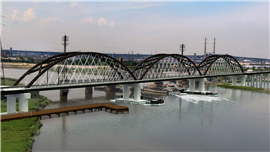 Render of the future Portal North Bridge over the Hackensack River in New Jersey, US. Image courtesy Skanska
Render of the future Portal North Bridge over the Hackensack River in New Jersey, US. Image courtesy Skanska
While conventional engineering still formed the backbone of planning, Skanska-Traylor employed a suite of digital tools to manage the high-stakes operations.
BIM models were used throughout design and construction phases, accompanied by EarthCam installations and real-time monitoring systems to validate performance and progress. Scheduling platforms helped maintain phasing discipline; highly vital for a site boxed in by water, rail, contaminated soil zones and urban sprawl.
“We used a little bit of everything, from BIM [building informatoin modelling] to scale models to field inspection tools,” said Borhi. “But we also relied on senior engineers doing the math by hand to double check that every lift, every barge movement, every piece of structural steel was aligned with the tides and correctly calculated.”
Survey precision was critical throughout, he added. “Our survey team helped make sure we were dialled in on all activities. We were within a 16th of an inch in the worst cases.”
To hedge against supply chain volatility, the team divided its steel fabrication among multiple suppliers. This helped keep work on schedule; Portal North work began in August 2022 and remains on track for its handoff to Amtrak in September 2025, with full bridge commissioning to follow.
Skanska-Traylor will remain on site into late 2026 supporting final track connections, after which the old Portal Bridge will be removed and recycled. The new bridge is scheduled to open to rail traffic in Q2 2026 and expected to be fully operational in Q4 the same year.
STAY CONNECTED


Receive the information you need when you need it through our world-leading magazines, newsletters and daily briefings.
CONNECT WITH THE TEAM









